ACC5215 Corporate Accounting Report: Wesfarmers Financial Analysis
VerifiedAdded on 2023/01/03
|16
|4004
|92
Report
AI Summary
This report provides a detailed analysis of Wesfarmers' financial performance and corporate governance, based on its 2018 annual report. Section 1 examines board composition, including the qualifications and experience of directors, and provides information on subsidiaries and associates. Part B focuses on a report for the annual general meeting, discussing income statement methods, profitability levels, future growth opportunities, corporate social responsibility, and key assumptions. Section 2 delves into the social contract between banks and the community, stakeholder roles, the impact of scandals, and strategies for improving organizational legitimacy, using the National Australian Bank (NAB) as a case study. The report highlights key financial ratios, identifies areas of stability and instability in profitability, and discusses Wesfarmers' approach to sustainability and future growth. The analysis provides insights into the company's financial health, governance practices, and its relationship with stakeholders.

1
ACC5215 Corporate Accounting
ACC5215 Corporate Accounting
Paraphrase This Document
Need a fresh take? Get an instant paraphrase of this document with our AI Paraphraser
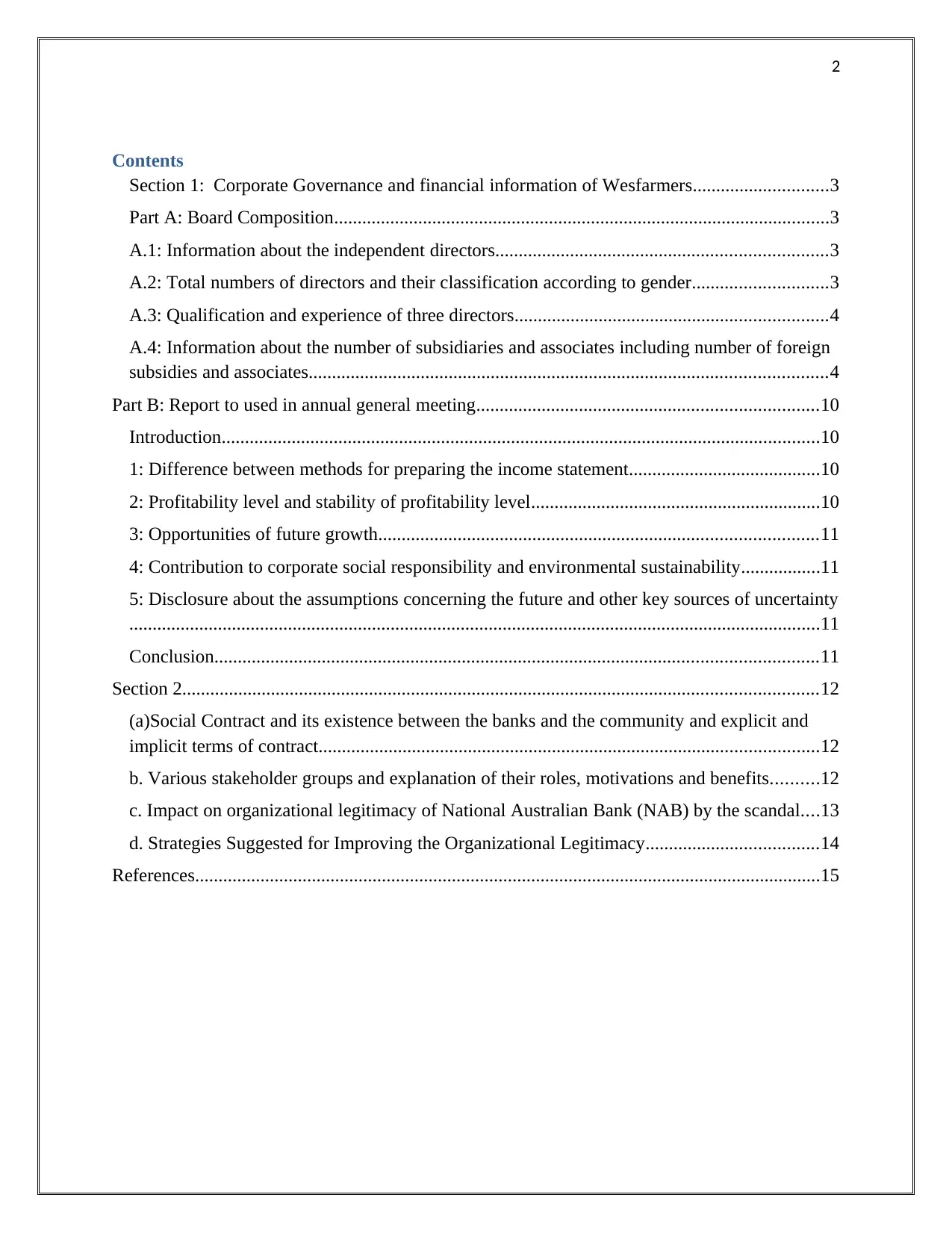
2
Contents
Section 1: Corporate Governance and financial information of Wesfarmers.............................3
Part A: Board Composition..........................................................................................................3
A.1: Information about the independent directors.......................................................................3
A.2: Total numbers of directors and their classification according to gender.............................3
A.3: Qualification and experience of three directors...................................................................4
A.4: Information about the number of subsidiaries and associates including number of foreign
subsidies and associates...............................................................................................................4
Part B: Report to used in annual general meeting.........................................................................10
Introduction................................................................................................................................10
1: Difference between methods for preparing the income statement.........................................10
2: Profitability level and stability of profitability level..............................................................10
3: Opportunities of future growth..............................................................................................11
4: Contribution to corporate social responsibility and environmental sustainability.................11
5: Disclosure about the assumptions concerning the future and other key sources of uncertainty
....................................................................................................................................................11
Conclusion.................................................................................................................................11
Section 2........................................................................................................................................12
(a)Social Contract and its existence between the banks and the community and explicit and
implicit terms of contract...........................................................................................................12
b. Various stakeholder groups and explanation of their roles, motivations and benefits..........12
c. Impact on organizational legitimacy of National Australian Bank (NAB) by the scandal....13
d. Strategies Suggested for Improving the Organizational Legitimacy.....................................14
References......................................................................................................................................15
Contents
Section 1: Corporate Governance and financial information of Wesfarmers.............................3
Part A: Board Composition..........................................................................................................3
A.1: Information about the independent directors.......................................................................3
A.2: Total numbers of directors and their classification according to gender.............................3
A.3: Qualification and experience of three directors...................................................................4
A.4: Information about the number of subsidiaries and associates including number of foreign
subsidies and associates...............................................................................................................4
Part B: Report to used in annual general meeting.........................................................................10
Introduction................................................................................................................................10
1: Difference between methods for preparing the income statement.........................................10
2: Profitability level and stability of profitability level..............................................................10
3: Opportunities of future growth..............................................................................................11
4: Contribution to corporate social responsibility and environmental sustainability.................11
5: Disclosure about the assumptions concerning the future and other key sources of uncertainty
....................................................................................................................................................11
Conclusion.................................................................................................................................11
Section 2........................................................................................................................................12
(a)Social Contract and its existence between the banks and the community and explicit and
implicit terms of contract...........................................................................................................12
b. Various stakeholder groups and explanation of their roles, motivations and benefits..........12
c. Impact on organizational legitimacy of National Australian Bank (NAB) by the scandal....13
d. Strategies Suggested for Improving the Organizational Legitimacy.....................................14
References......................................................................................................................................15
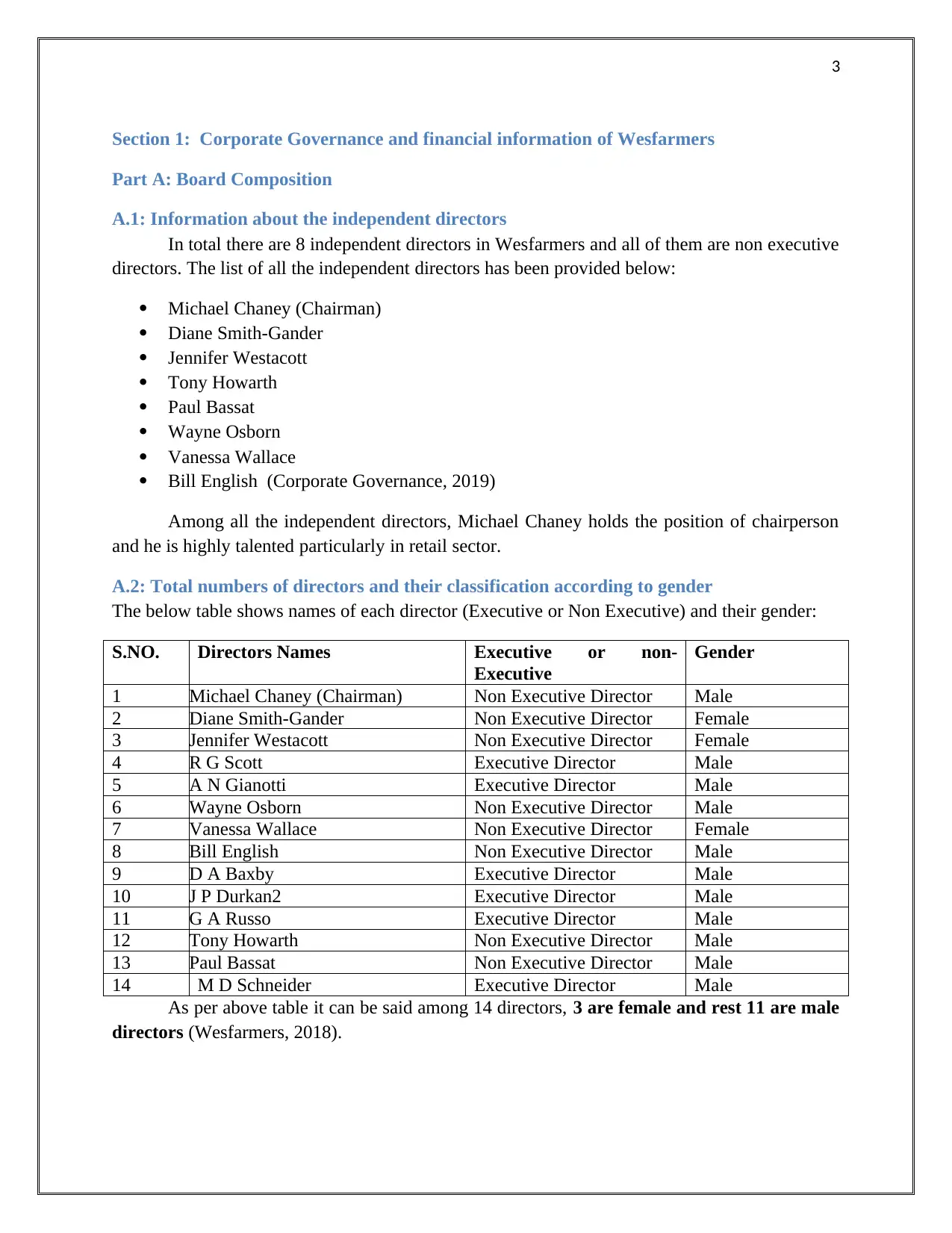
3
Section 1: Corporate Governance and financial information of Wesfarmers
Part A: Board Composition
A.1: Information about the independent directors
In total there are 8 independent directors in Wesfarmers and all of them are non executive
directors. The list of all the independent directors has been provided below:
Michael Chaney (Chairman)
Diane Smith-Gander
Jennifer Westacott
Tony Howarth
Paul Bassat
Wayne Osborn
Vanessa Wallace
Bill English (Corporate Governance, 2019)
Among all the independent directors, Michael Chaney holds the position of chairperson
and he is highly talented particularly in retail sector.
A.2: Total numbers of directors and their classification according to gender
The below table shows names of each director (Executive or Non Executive) and their gender:
S.NO. Directors Names Executive or non-
Executive
Gender
1 Michael Chaney (Chairman) Non Executive Director Male
2 Diane Smith-Gander Non Executive Director Female
3 Jennifer Westacott Non Executive Director Female
4 R G Scott Executive Director Male
5 A N Gianotti Executive Director Male
6 Wayne Osborn Non Executive Director Male
7 Vanessa Wallace Non Executive Director Female
8 Bill English Non Executive Director Male
9 D A Baxby Executive Director Male
10 J P Durkan2 Executive Director Male
11 G A Russo Executive Director Male
12 Tony Howarth Non Executive Director Male
13 Paul Bassat Non Executive Director Male
14 M D Schneider Executive Director Male
As per above table it can be said among 14 directors, 3 are female and rest 11 are male
directors (Wesfarmers, 2018).
Section 1: Corporate Governance and financial information of Wesfarmers
Part A: Board Composition
A.1: Information about the independent directors
In total there are 8 independent directors in Wesfarmers and all of them are non executive
directors. The list of all the independent directors has been provided below:
Michael Chaney (Chairman)
Diane Smith-Gander
Jennifer Westacott
Tony Howarth
Paul Bassat
Wayne Osborn
Vanessa Wallace
Bill English (Corporate Governance, 2019)
Among all the independent directors, Michael Chaney holds the position of chairperson
and he is highly talented particularly in retail sector.
A.2: Total numbers of directors and their classification according to gender
The below table shows names of each director (Executive or Non Executive) and their gender:
S.NO. Directors Names Executive or non-
Executive
Gender
1 Michael Chaney (Chairman) Non Executive Director Male
2 Diane Smith-Gander Non Executive Director Female
3 Jennifer Westacott Non Executive Director Female
4 R G Scott Executive Director Male
5 A N Gianotti Executive Director Male
6 Wayne Osborn Non Executive Director Male
7 Vanessa Wallace Non Executive Director Female
8 Bill English Non Executive Director Male
9 D A Baxby Executive Director Male
10 J P Durkan2 Executive Director Male
11 G A Russo Executive Director Male
12 Tony Howarth Non Executive Director Male
13 Paul Bassat Non Executive Director Male
14 M D Schneider Executive Director Male
As per above table it can be said among 14 directors, 3 are female and rest 11 are male
directors (Wesfarmers, 2018).
⊘ This is a preview!⊘
Do you want full access?
Subscribe today to unlock all pages.

Trusted by 1+ million students worldwide
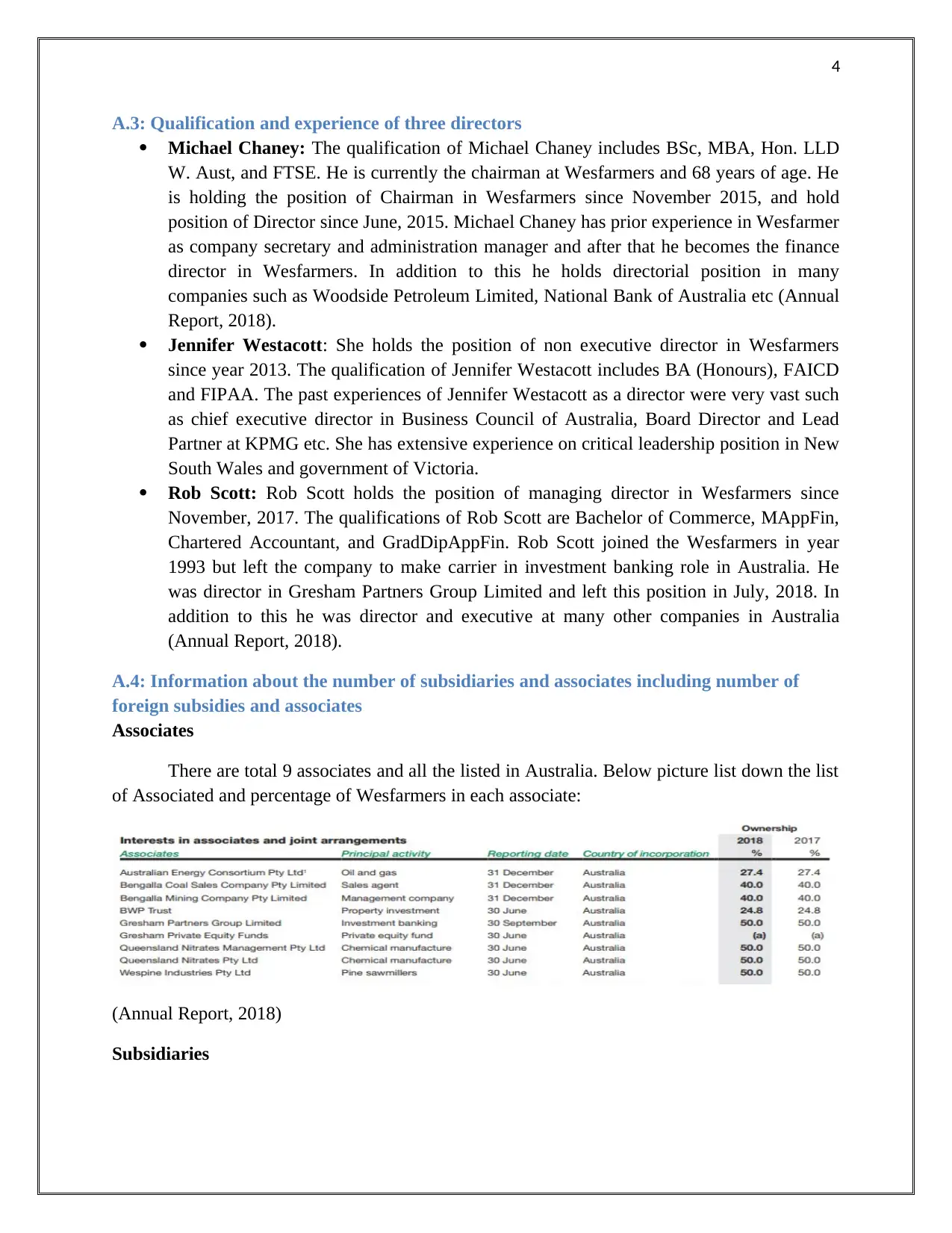
4
A.3: Qualification and experience of three directors
Michael Chaney: The qualification of Michael Chaney includes BSc, MBA, Hon. LLD
W. Aust, and FTSE. He is currently the chairman at Wesfarmers and 68 years of age. He
is holding the position of Chairman in Wesfarmers since November 2015, and hold
position of Director since June, 2015. Michael Chaney has prior experience in Wesfarmer
as company secretary and administration manager and after that he becomes the finance
director in Wesfarmers. In addition to this he holds directorial position in many
companies such as Woodside Petroleum Limited, National Bank of Australia etc (Annual
Report, 2018).
Jennifer Westacott: She holds the position of non executive director in Wesfarmers
since year 2013. The qualification of Jennifer Westacott includes BA (Honours), FAICD
and FIPAA. The past experiences of Jennifer Westacott as a director were very vast such
as chief executive director in Business Council of Australia, Board Director and Lead
Partner at KPMG etc. She has extensive experience on critical leadership position in New
South Wales and government of Victoria.
Rob Scott: Rob Scott holds the position of managing director in Wesfarmers since
November, 2017. The qualifications of Rob Scott are Bachelor of Commerce, MAppFin,
Chartered Accountant, and GradDipAppFin. Rob Scott joined the Wesfarmers in year
1993 but left the company to make carrier in investment banking role in Australia. He
was director in Gresham Partners Group Limited and left this position in July, 2018. In
addition to this he was director and executive at many other companies in Australia
(Annual Report, 2018).
A.4: Information about the number of subsidiaries and associates including number of
foreign subsidies and associates
Associates
There are total 9 associates and all the listed in Australia. Below picture list down the list
of Associated and percentage of Wesfarmers in each associate:
(Annual Report, 2018)
Subsidiaries
A.3: Qualification and experience of three directors
Michael Chaney: The qualification of Michael Chaney includes BSc, MBA, Hon. LLD
W. Aust, and FTSE. He is currently the chairman at Wesfarmers and 68 years of age. He
is holding the position of Chairman in Wesfarmers since November 2015, and hold
position of Director since June, 2015. Michael Chaney has prior experience in Wesfarmer
as company secretary and administration manager and after that he becomes the finance
director in Wesfarmers. In addition to this he holds directorial position in many
companies such as Woodside Petroleum Limited, National Bank of Australia etc (Annual
Report, 2018).
Jennifer Westacott: She holds the position of non executive director in Wesfarmers
since year 2013. The qualification of Jennifer Westacott includes BA (Honours), FAICD
and FIPAA. The past experiences of Jennifer Westacott as a director were very vast such
as chief executive director in Business Council of Australia, Board Director and Lead
Partner at KPMG etc. She has extensive experience on critical leadership position in New
South Wales and government of Victoria.
Rob Scott: Rob Scott holds the position of managing director in Wesfarmers since
November, 2017. The qualifications of Rob Scott are Bachelor of Commerce, MAppFin,
Chartered Accountant, and GradDipAppFin. Rob Scott joined the Wesfarmers in year
1993 but left the company to make carrier in investment banking role in Australia. He
was director in Gresham Partners Group Limited and left this position in July, 2018. In
addition to this he was director and executive at many other companies in Australia
(Annual Report, 2018).
A.4: Information about the number of subsidiaries and associates including number of
foreign subsidies and associates
Associates
There are total 9 associates and all the listed in Australia. Below picture list down the list
of Associated and percentage of Wesfarmers in each associate:
(Annual Report, 2018)
Subsidiaries
Paraphrase This Document
Need a fresh take? Get an instant paraphrase of this document with our AI Paraphraser
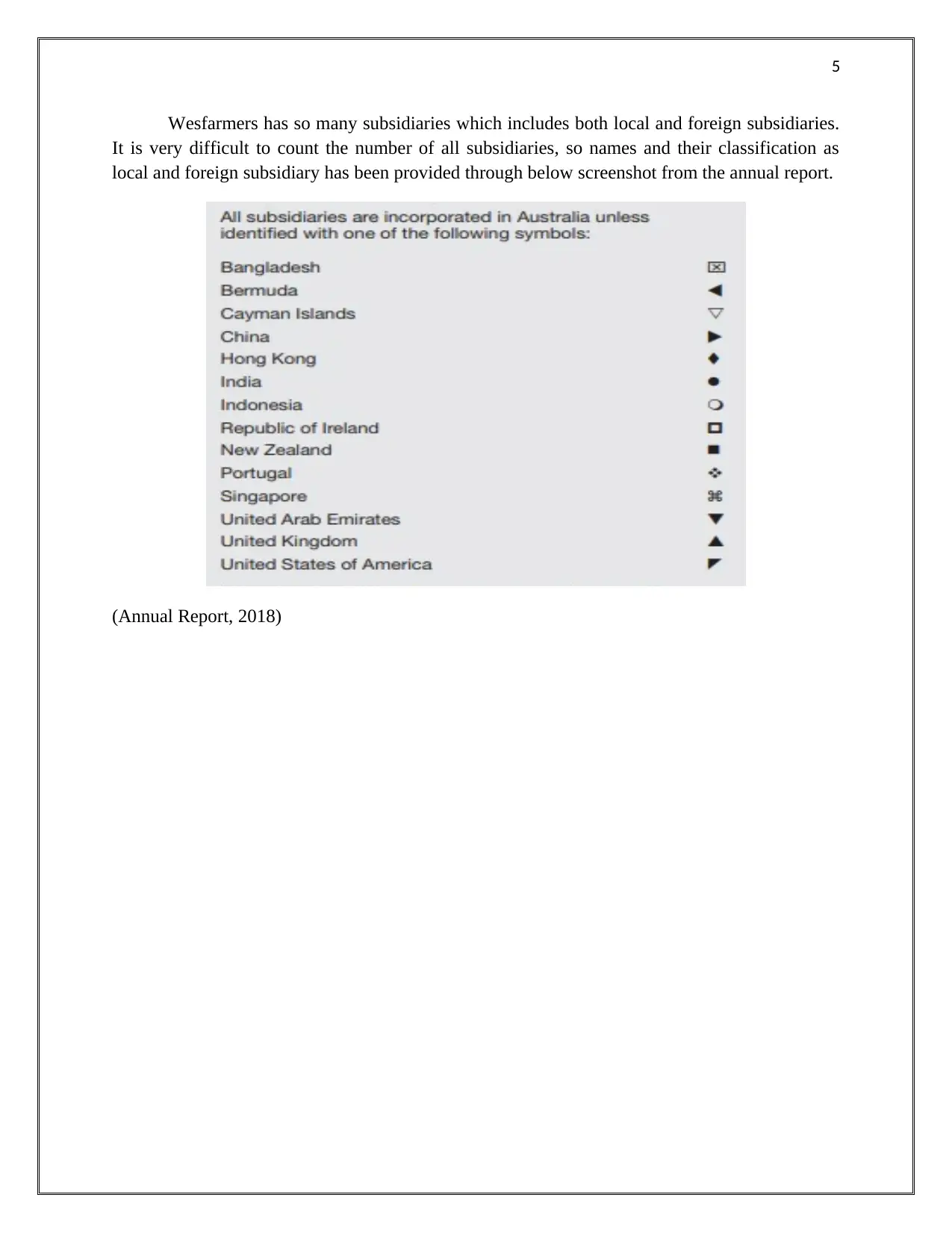
5
Wesfarmers has so many subsidiaries which includes both local and foreign subsidiaries.
It is very difficult to count the number of all subsidiaries, so names and their classification as
local and foreign subsidiary has been provided through below screenshot from the annual report.
(Annual Report, 2018)
Wesfarmers has so many subsidiaries which includes both local and foreign subsidiaries.
It is very difficult to count the number of all subsidiaries, so names and their classification as
local and foreign subsidiary has been provided through below screenshot from the annual report.
(Annual Report, 2018)

6
⊘ This is a preview!⊘
Do you want full access?
Subscribe today to unlock all pages.

Trusted by 1+ million students worldwide

7
Paraphrase This Document
Need a fresh take? Get an instant paraphrase of this document with our AI Paraphraser
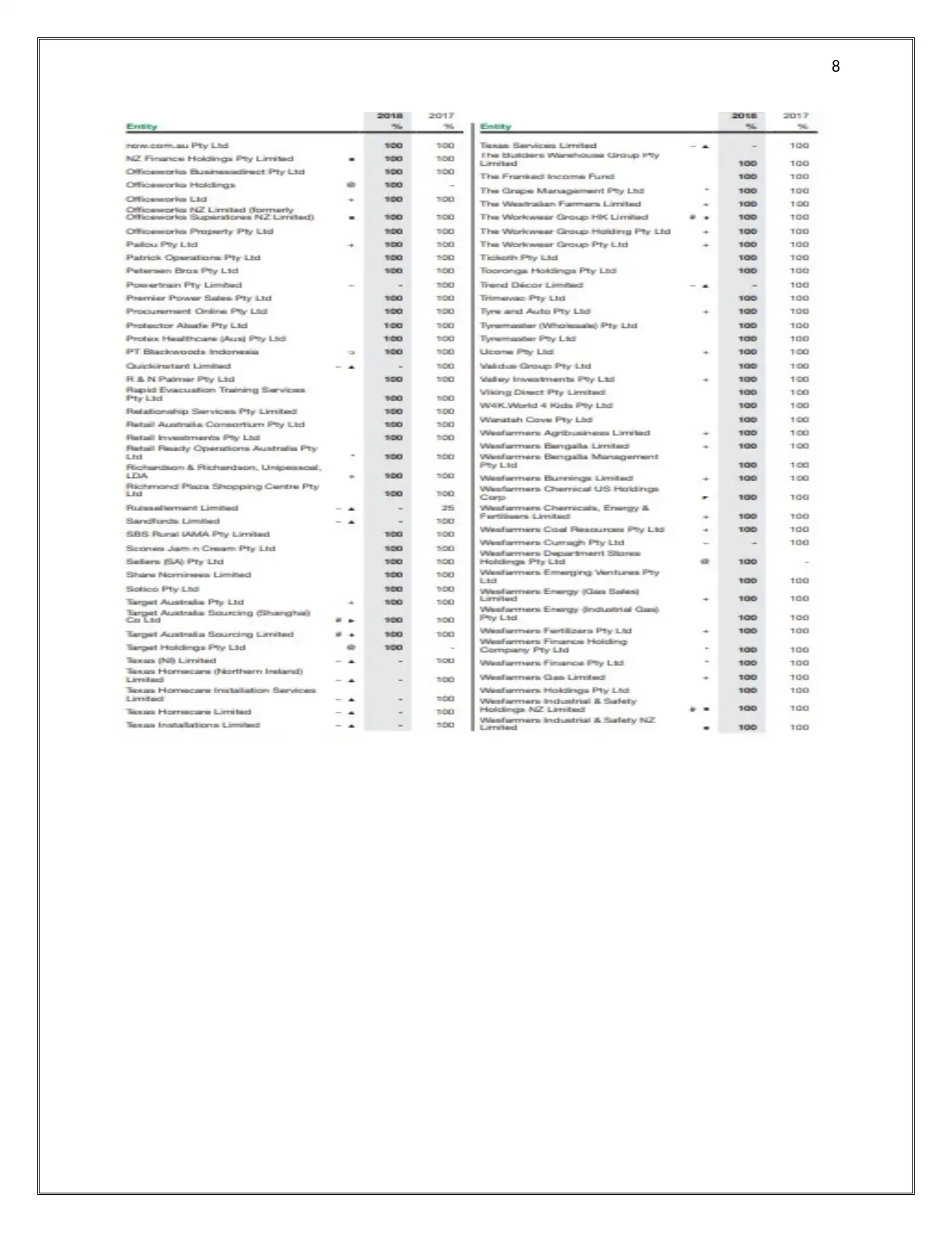
8
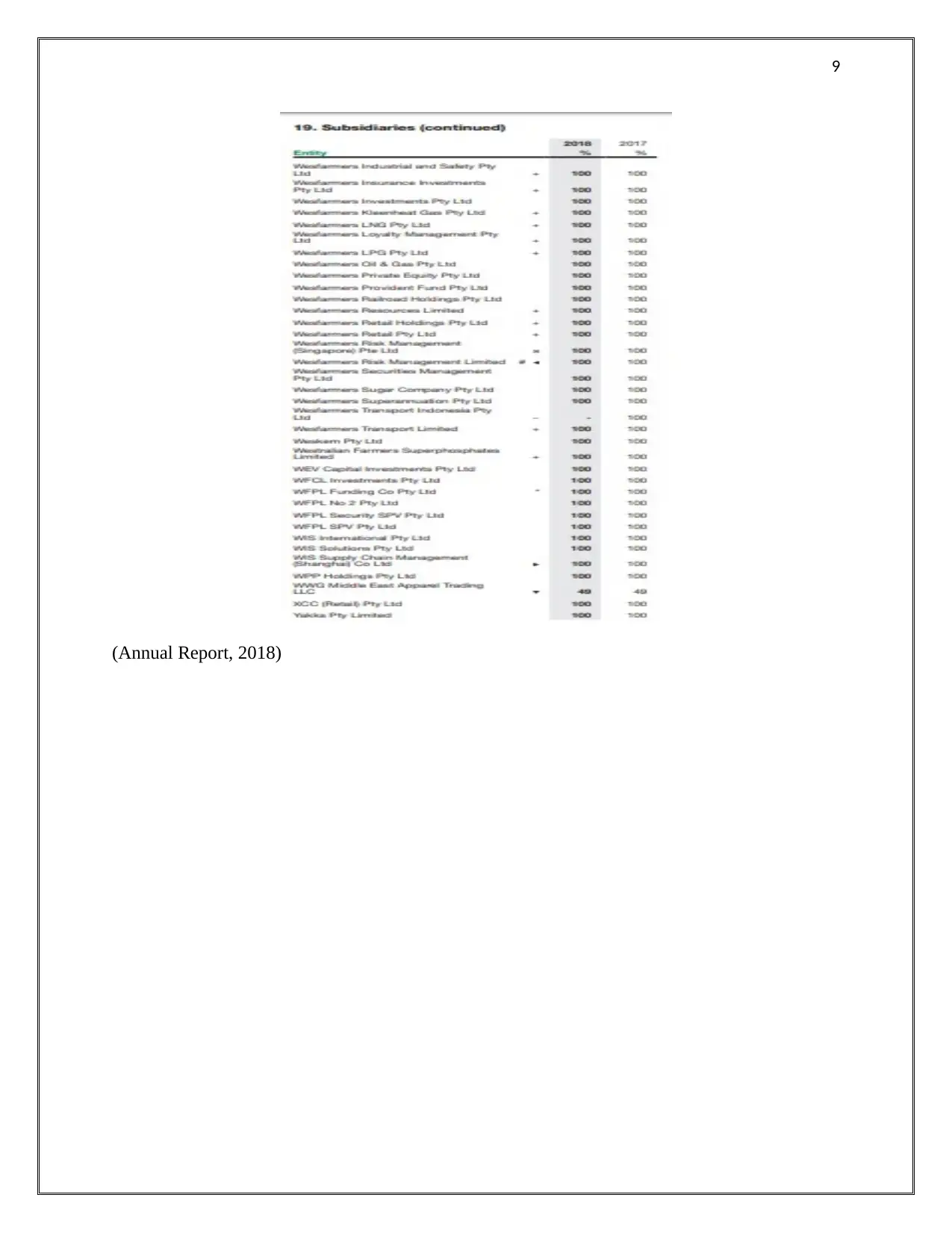
9
(Annual Report, 2018)
(Annual Report, 2018)
⊘ This is a preview!⊘
Do you want full access?
Subscribe today to unlock all pages.

Trusted by 1+ million students worldwide
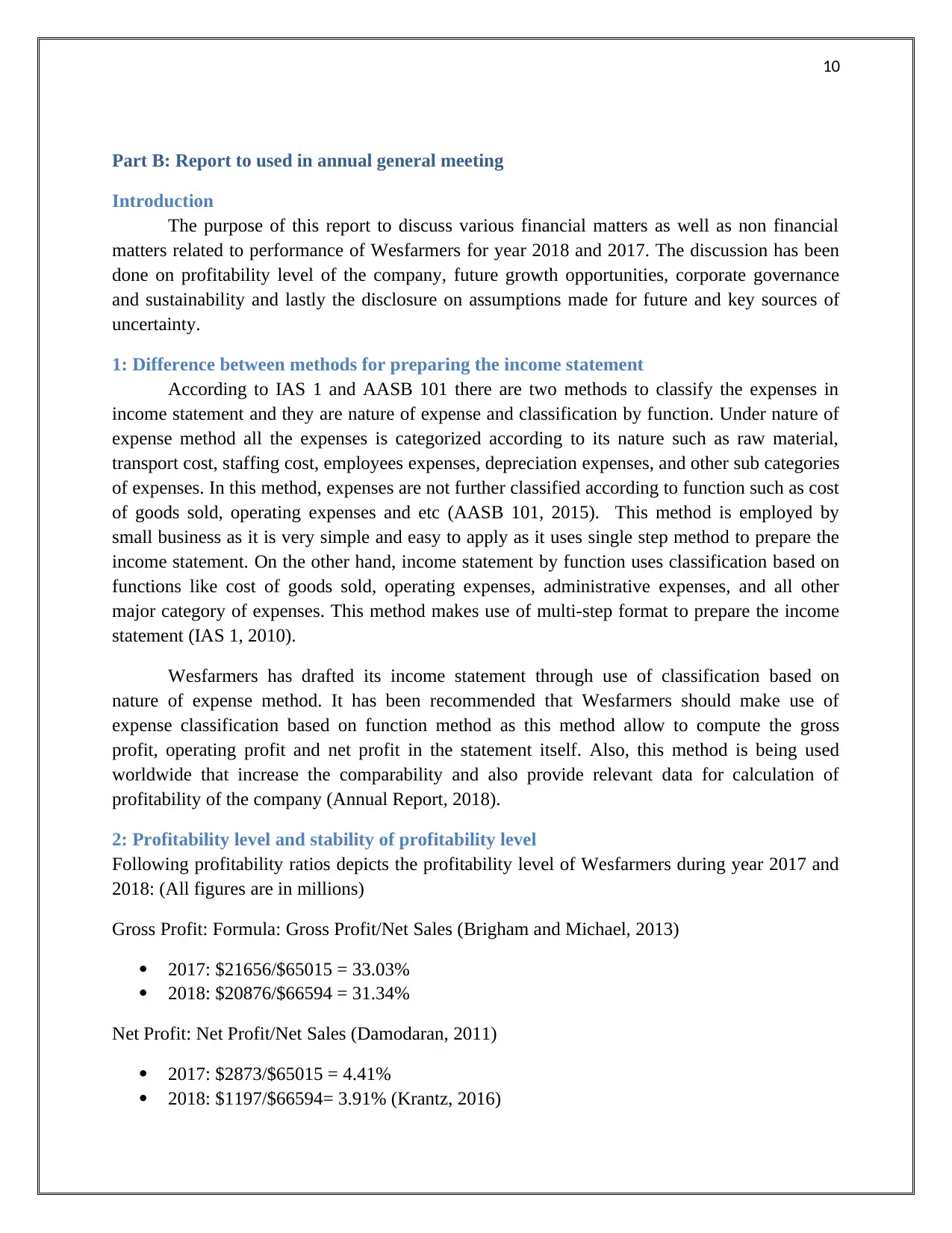
10
Part B: Report to used in annual general meeting
Introduction
The purpose of this report to discuss various financial matters as well as non financial
matters related to performance of Wesfarmers for year 2018 and 2017. The discussion has been
done on profitability level of the company, future growth opportunities, corporate governance
and sustainability and lastly the disclosure on assumptions made for future and key sources of
uncertainty.
1: Difference between methods for preparing the income statement
According to IAS 1 and AASB 101 there are two methods to classify the expenses in
income statement and they are nature of expense and classification by function. Under nature of
expense method all the expenses is categorized according to its nature such as raw material,
transport cost, staffing cost, employees expenses, depreciation expenses, and other sub categories
of expenses. In this method, expenses are not further classified according to function such as cost
of goods sold, operating expenses and etc (AASB 101, 2015). This method is employed by
small business as it is very simple and easy to apply as it uses single step method to prepare the
income statement. On the other hand, income statement by function uses classification based on
functions like cost of goods sold, operating expenses, administrative expenses, and all other
major category of expenses. This method makes use of multi-step format to prepare the income
statement (IAS 1, 2010).
Wesfarmers has drafted its income statement through use of classification based on
nature of expense method. It has been recommended that Wesfarmers should make use of
expense classification based on function method as this method allow to compute the gross
profit, operating profit and net profit in the statement itself. Also, this method is being used
worldwide that increase the comparability and also provide relevant data for calculation of
profitability of the company (Annual Report, 2018).
2: Profitability level and stability of profitability level
Following profitability ratios depicts the profitability level of Wesfarmers during year 2017 and
2018: (All figures are in millions)
Gross Profit: Formula: Gross Profit/Net Sales (Brigham and Michael, 2013)
2017: $21656/$65015 = 33.03%
2018: $20876/$66594 = 31.34%
Net Profit: Net Profit/Net Sales (Damodaran, 2011)
2017: $2873/$65015 = 4.41%
2018: $1197/$66594= 3.91% (Krantz, 2016)
Part B: Report to used in annual general meeting
Introduction
The purpose of this report to discuss various financial matters as well as non financial
matters related to performance of Wesfarmers for year 2018 and 2017. The discussion has been
done on profitability level of the company, future growth opportunities, corporate governance
and sustainability and lastly the disclosure on assumptions made for future and key sources of
uncertainty.
1: Difference between methods for preparing the income statement
According to IAS 1 and AASB 101 there are two methods to classify the expenses in
income statement and they are nature of expense and classification by function. Under nature of
expense method all the expenses is categorized according to its nature such as raw material,
transport cost, staffing cost, employees expenses, depreciation expenses, and other sub categories
of expenses. In this method, expenses are not further classified according to function such as cost
of goods sold, operating expenses and etc (AASB 101, 2015). This method is employed by
small business as it is very simple and easy to apply as it uses single step method to prepare the
income statement. On the other hand, income statement by function uses classification based on
functions like cost of goods sold, operating expenses, administrative expenses, and all other
major category of expenses. This method makes use of multi-step format to prepare the income
statement (IAS 1, 2010).
Wesfarmers has drafted its income statement through use of classification based on
nature of expense method. It has been recommended that Wesfarmers should make use of
expense classification based on function method as this method allow to compute the gross
profit, operating profit and net profit in the statement itself. Also, this method is being used
worldwide that increase the comparability and also provide relevant data for calculation of
profitability of the company (Annual Report, 2018).
2: Profitability level and stability of profitability level
Following profitability ratios depicts the profitability level of Wesfarmers during year 2017 and
2018: (All figures are in millions)
Gross Profit: Formula: Gross Profit/Net Sales (Brigham and Michael, 2013)
2017: $21656/$65015 = 33.03%
2018: $20876/$66594 = 31.34%
Net Profit: Net Profit/Net Sales (Damodaran, 2011)
2017: $2873/$65015 = 4.41%
2018: $1197/$66594= 3.91% (Krantz, 2016)
Paraphrase This Document
Need a fresh take? Get an instant paraphrase of this document with our AI Paraphraser

11
The level of profitability attained by Wesfarmers in year 2017 & 2018 was better than the
previous years it is not satisfactory. There has been no stability in profitability level of
Wesfarmers as in year 2015 company had faced major loss but in the next year recovered the
losses and earned good percentage of net profit in year 2016. In year 2017 and 2018 there was no
stability in profits as there was downshift in profits (Aguilera, 2018).
3: Opportunities of future growth
In next year Wesfarmers is looking to demerge Coles’s business so that all the growth
opportunities can be diverted to earn the maximum revenue. Wesfarmers will focus on increasing
the digital capabilities to acquire new market and to develop talent and team to drive this
initiative. The popular business segment of Wesfarmers, Coles is planning to open new physical
stores in many other locations of Australia and Worldwide to capture the new market and to
drive the growth in business (Annual Report, 2018).
4: Contribution to corporate social responsibility and environmental sustainability
Wesfarmers actively disclose all the actions and strategies it takes to make sure its
activities drives lowest amount of green houses gases and keep the environment safe and clean.
In addition to this company takes all measures required to make sure health of employees,
customers and other personal remain at first priority while producing the goods and services and
delivering the same to customers (Afza, 2014). All the disclosures related to the sustainability
and corporate social responsibility has been provided in annual report of year 2018 (Annual
Report, 2018).
5: Disclosure about the assumptions concerning the future and other key sources of
uncertainty
Wesfarmers has provided detailed disclosures regarding the assumptions and key
estimates made for future expects and calculation of various financial items such as income; tax
expenses; property, plant and equipment; goodwill and intangible assets; provisions; contingent
assets and liabilities and treatment of gains or losses from associates and joint arrangements
(Davies and Crawford, 2011).
Conclusion
This report has provided all the detailed financial and non financial performance
disclosure made by Wesfarmers in its annual report of year 2018. There has been no stability in
profitability level and profitability level had also decreased in year 2018 as compared to year
2017.
The level of profitability attained by Wesfarmers in year 2017 & 2018 was better than the
previous years it is not satisfactory. There has been no stability in profitability level of
Wesfarmers as in year 2015 company had faced major loss but in the next year recovered the
losses and earned good percentage of net profit in year 2016. In year 2017 and 2018 there was no
stability in profits as there was downshift in profits (Aguilera, 2018).
3: Opportunities of future growth
In next year Wesfarmers is looking to demerge Coles’s business so that all the growth
opportunities can be diverted to earn the maximum revenue. Wesfarmers will focus on increasing
the digital capabilities to acquire new market and to develop talent and team to drive this
initiative. The popular business segment of Wesfarmers, Coles is planning to open new physical
stores in many other locations of Australia and Worldwide to capture the new market and to
drive the growth in business (Annual Report, 2018).
4: Contribution to corporate social responsibility and environmental sustainability
Wesfarmers actively disclose all the actions and strategies it takes to make sure its
activities drives lowest amount of green houses gases and keep the environment safe and clean.
In addition to this company takes all measures required to make sure health of employees,
customers and other personal remain at first priority while producing the goods and services and
delivering the same to customers (Afza, 2014). All the disclosures related to the sustainability
and corporate social responsibility has been provided in annual report of year 2018 (Annual
Report, 2018).
5: Disclosure about the assumptions concerning the future and other key sources of
uncertainty
Wesfarmers has provided detailed disclosures regarding the assumptions and key
estimates made for future expects and calculation of various financial items such as income; tax
expenses; property, plant and equipment; goodwill and intangible assets; provisions; contingent
assets and liabilities and treatment of gains or losses from associates and joint arrangements
(Davies and Crawford, 2011).
Conclusion
This report has provided all the detailed financial and non financial performance
disclosure made by Wesfarmers in its annual report of year 2018. There has been no stability in
profitability level and profitability level had also decreased in year 2018 as compared to year
2017.
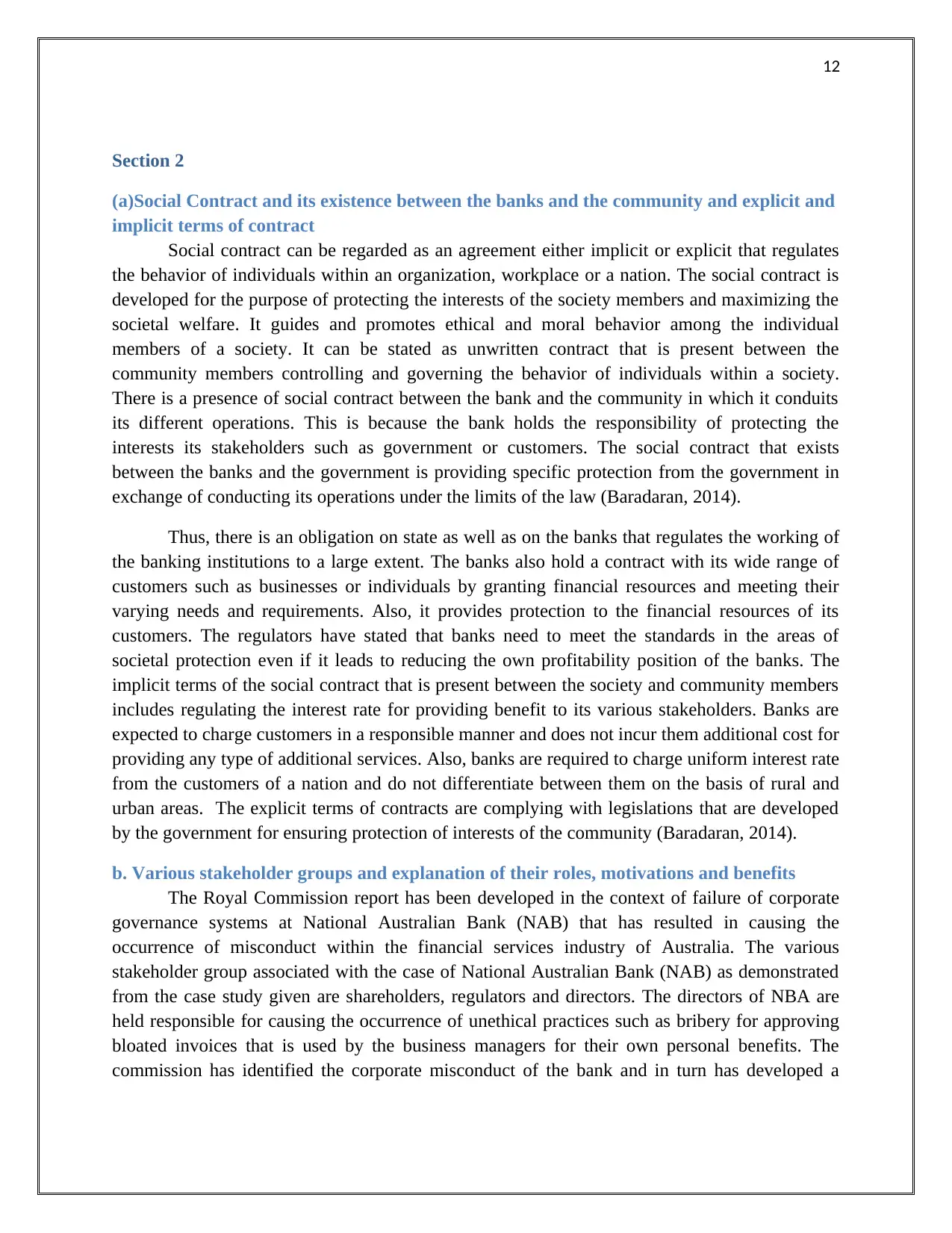
12
Section 2
(a)Social Contract and its existence between the banks and the community and explicit and
implicit terms of contract
Social contract can be regarded as an agreement either implicit or explicit that regulates
the behavior of individuals within an organization, workplace or a nation. The social contract is
developed for the purpose of protecting the interests of the society members and maximizing the
societal welfare. It guides and promotes ethical and moral behavior among the individual
members of a society. It can be stated as unwritten contract that is present between the
community members controlling and governing the behavior of individuals within a society.
There is a presence of social contract between the bank and the community in which it conduits
its different operations. This is because the bank holds the responsibility of protecting the
interests its stakeholders such as government or customers. The social contract that exists
between the banks and the government is providing specific protection from the government in
exchange of conducting its operations under the limits of the law (Baradaran, 2014).
Thus, there is an obligation on state as well as on the banks that regulates the working of
the banking institutions to a large extent. The banks also hold a contract with its wide range of
customers such as businesses or individuals by granting financial resources and meeting their
varying needs and requirements. Also, it provides protection to the financial resources of its
customers. The regulators have stated that banks need to meet the standards in the areas of
societal protection even if it leads to reducing the own profitability position of the banks. The
implicit terms of the social contract that is present between the society and community members
includes regulating the interest rate for providing benefit to its various stakeholders. Banks are
expected to charge customers in a responsible manner and does not incur them additional cost for
providing any type of additional services. Also, banks are required to charge uniform interest rate
from the customers of a nation and do not differentiate between them on the basis of rural and
urban areas. The explicit terms of contracts are complying with legislations that are developed
by the government for ensuring protection of interests of the community (Baradaran, 2014).
b. Various stakeholder groups and explanation of their roles, motivations and benefits
The Royal Commission report has been developed in the context of failure of corporate
governance systems at National Australian Bank (NAB) that has resulted in causing the
occurrence of misconduct within the financial services industry of Australia. The various
stakeholder group associated with the case of National Australian Bank (NAB) as demonstrated
from the case study given are shareholders, regulators and directors. The directors of NBA are
held responsible for causing the occurrence of unethical practices such as bribery for approving
bloated invoices that is used by the business managers for their own personal benefits. The
commission has identified the corporate misconduct of the bank and in turn has developed a
Section 2
(a)Social Contract and its existence between the banks and the community and explicit and
implicit terms of contract
Social contract can be regarded as an agreement either implicit or explicit that regulates
the behavior of individuals within an organization, workplace or a nation. The social contract is
developed for the purpose of protecting the interests of the society members and maximizing the
societal welfare. It guides and promotes ethical and moral behavior among the individual
members of a society. It can be stated as unwritten contract that is present between the
community members controlling and governing the behavior of individuals within a society.
There is a presence of social contract between the bank and the community in which it conduits
its different operations. This is because the bank holds the responsibility of protecting the
interests its stakeholders such as government or customers. The social contract that exists
between the banks and the government is providing specific protection from the government in
exchange of conducting its operations under the limits of the law (Baradaran, 2014).
Thus, there is an obligation on state as well as on the banks that regulates the working of
the banking institutions to a large extent. The banks also hold a contract with its wide range of
customers such as businesses or individuals by granting financial resources and meeting their
varying needs and requirements. Also, it provides protection to the financial resources of its
customers. The regulators have stated that banks need to meet the standards in the areas of
societal protection even if it leads to reducing the own profitability position of the banks. The
implicit terms of the social contract that is present between the society and community members
includes regulating the interest rate for providing benefit to its various stakeholders. Banks are
expected to charge customers in a responsible manner and does not incur them additional cost for
providing any type of additional services. Also, banks are required to charge uniform interest rate
from the customers of a nation and do not differentiate between them on the basis of rural and
urban areas. The explicit terms of contracts are complying with legislations that are developed
by the government for ensuring protection of interests of the community (Baradaran, 2014).
b. Various stakeholder groups and explanation of their roles, motivations and benefits
The Royal Commission report has been developed in the context of failure of corporate
governance systems at National Australian Bank (NAB) that has resulted in causing the
occurrence of misconduct within the financial services industry of Australia. The various
stakeholder group associated with the case of National Australian Bank (NAB) as demonstrated
from the case study given are shareholders, regulators and directors. The directors of NBA are
held responsible for causing the occurrence of unethical practices such as bribery for approving
bloated invoices that is used by the business managers for their own personal benefits. The
commission has identified the corporate misconduct of the bank and in turn has developed a
⊘ This is a preview!⊘
Do you want full access?
Subscribe today to unlock all pages.

Trusted by 1+ million students worldwide
1 out of 16
Your All-in-One AI-Powered Toolkit for Academic Success.
+13062052269
info@desklib.com
Available 24*7 on WhatsApp / Email
![[object Object]](/_next/static/media/star-bottom.7253800d.svg)
Unlock your academic potential
Copyright © 2020–2025 A2Z Services. All Rights Reserved. Developed and managed by ZUCOL.

